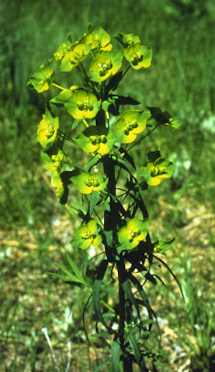 Description:
Description:  Description:
Description: Flowers: The flowers come from petal-like structures called bracts (the cover of the flower that holds it to the stem) (1, 2). The yellow bracts appear in May (3). Three to eight days after its pistil stigmas open up and are available to pollen the glands begin to secrete nectar that is orange and sticky when ripe (7).
Seeds/Fruit: Seeds grow in the pods on top of the bract (1, 3). The pod is the fruit. When mature, the pods burst open and throw seeds up to 15 feet from its parent plant (3). Each stem can produce 150 to 200 seeds. (7) There can be up to 350 to 1,000 seeds per sq. ft. (7). The seeds can germinate (grow) up to 8 years after thrown from is parent plant (3). For the seeds to grow there must be at least a weeks worth of days that are 78 to 82 degrees (7). They are smooth, oblong, and light gray to dark brown in color (1). To check the maturity of a seed you can break its fruit open and look at the color of it (it is dark when mature) (7).
Methods of Reproduction/Spread:
Reproduction
occurs by the regrowth from spreading roots and also by
the
production of large amounts of seeds spread by birds,
wildlife,
humans,
and rivers and streams (4). They spread from spreading
roots,
production
of large amounts of seeds, and by the shooting of seeds off of
its
parent plant (1-4). Thus, each year plants can grow up
to 15 feet
away
from the origional patch of spurge; this makes it hard to keep
it from
spreading and to get rid of it each
year (7).
Life Style/Habits/Life Duration: Leafy spurge begins its growth each year in early spring (5). It grows from the buds on the crown, roots, and from the seeds (5). In late April, in the northern climates, the buds on the roots usually begins to grow. The period of seed germination in the northern climates is late May to early June. 20 to 30 days after flowering the seeds develop (5). It will usually grow where there is the least opposition from native plants (8).
Montana infestation/history:
It
occurs in every county in Montana (2).
Environments favorable to infestation: Both dry and wet climates are homes of leafy spurge (2). It is found in continental Europe to southern countries like Spain, the Balkans, and Italy (7). Montana, Idaho, Wyoming, and North and South Dakota have the most infested US states and with Canada's provinces it infests over 2.7 million acres of land in the Great Plains (7). It will also grow in subtropical to subartic regions (7).
Impacts: Decreases native
plant life, increases erosion, and sap is toxic to animals
(2). The
milky latex is poisonous to some animals and can cause
irritation on
skin (4). In
cattle it causes scours and weaknesses; if eaten in large
amounts it
can cause death (4). In 1995, the cost of control in
Montana,
North and South Dakota, and Wyoming was at an estimated
144,350,000
dollars (6). The average cost per year to battle it is
over $110
million (9). In North Dakota it costs $11 million
annualy to fix
recreational areas and wildlife habitat (9).
Comments: Leafy spurge is
a
huge
problem that gets bigger all the time (2). It is
difficult to
kill
or control by chemicals and basically impossible to control by
cultural
or
physical methods (4). However, sheep and goats can be
taught to
eat it
and will have an impact on infestations (4).
Native Range/Probable Entry Into N.
America: Native to Europe and Asia
(6). It
was introduced from Eurasia in 1827 (3). It was found in
North
Dakota in 1909 (7).
Methods of control: You
will
usually want to use these in some sort of combination with one
another (8).
Chemical:
You
want to use
chemicals that will leave behind the least amount of toxic
residue
(10). The best
long-term control strategy is to use a herbicide treatment
program that
uses annual applications (5). Fall treatments control
well-established leafy spurge plants quite effectively
(3). For
leafy spurge, Tordon is the most effective
herbicide to use (3). For best results, use a gallon of
Tordon
per acre in the
spring, during flowering development (3).
2.) Breitenfeldt, Todd, Personal Interview, Biology Teacher, Whitehall School, Box 1109, Whitehall, Mt 59759. (406) 287-3862. 9-1-99.
3.) Moomaw, R.S., et., al., Ed., Leafy Spurge. [Online] Available http://www.ianr.unl.edu/pubs/Weeds/g834.htm, revised February 1989, 2/3/99.
4.) Rees, Norman, et. al., Ed., Biological Control of Weeds in the West, Western Society of Weed Science, in cooperation with USDA ARS, MT Dept. of Ag, and MT State Univ., Color World Printers, Bozeman, MT, Feb., 1996.
5.) Lujeunesse, Sherry. et., al., Ed., 1995, Leafy Spurge; Biology, Ecology and Management, Pamphlet, EB 134, July 1995, Montana State University, Bozeman, Montana 59759.
6.) Spencer, Neal R., Insects Up-Plants Down:
Towards Control
of Leafy Spurge, Euphorbia esula L. On The Great
Northern
Plains,
[Online] Available, http://ext.agn.uiuc.edu/abstract/145.html,
Updated February 1997, 9/29/99.
7.) Messersmith, C.G. "The Leafy Spurge Plant" Purge Spurge.
1995 ed.
CD-ROM. Bozeman,MT. USDA Agricultural Research Service In
Cooperation
with Montana State University.1995.
8.) Beck, K.G. "leafy spurge".2005. ext.colostate.edu.
14
January 2006
http://www.ext.colostate.edu/pubs/natres/03107.html
9.) Muller et al., "Damage".2000. efn.org. 13 January
2006 http://www.efn.org/~ipmpa/index.shtml.
updated August 20, 2000.
10.) Lajuenesse et al. "Leafy Spurge: Biology, Ecology,
and Management". July. 1995: EB 134.
11.) Sedivec et al., "leafy spurge".2000. efn.org., 13 January 2006 http://www.efn.org/~ipmpa/index.shtml .